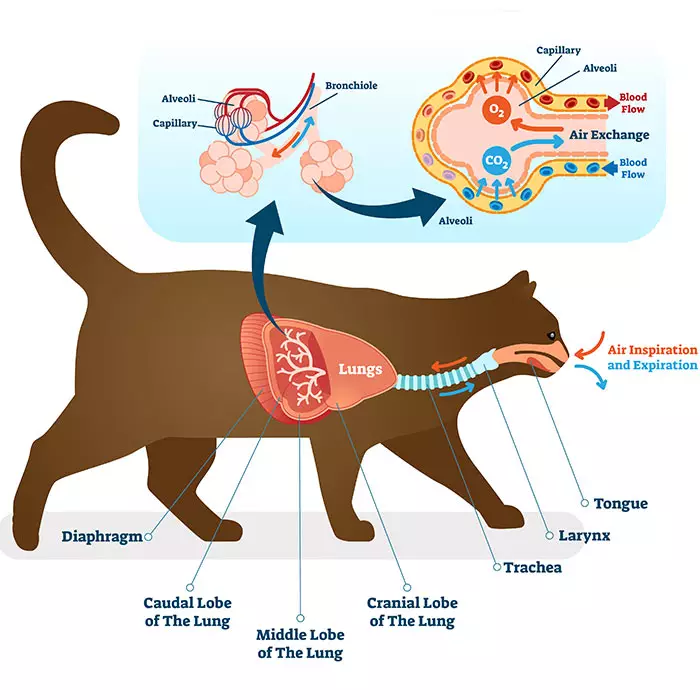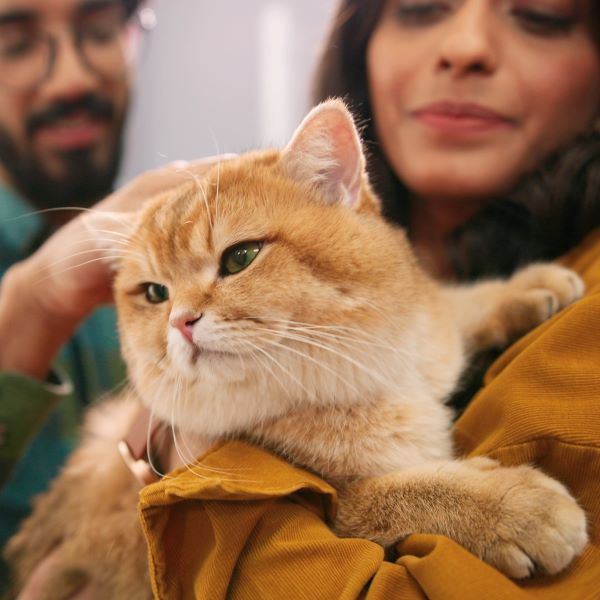Respiratory tract infection (RTIs) in cats
What is respiratory tract infection?
A respiratory tract infection (RTIs) is an infectious disease that can affect the nose, sinuses and throat (upper respiratory tract) or the airways or lungs (lower respiratory tract). It is the less serious upper respiratory tract infections (URTI), which are much like the common cold in humans, that commonly occur in cats. URTI’s are highly contagious among cats and have the potential to progress down the respiratory tract to the lungs and develop into a far more serious lower respiratory infection, such as pneumonia .
Upper respiratory tract infection in cats is also referred to as Feline Infectious Respiratory Disease or Feline Upper Respiratory Disease Complex (URD). It is a common illness because a cat’s nose, throat and sinuses are susceptible to infections caused by a variety of viruses and bacteria. Once a cat is exposed to an infectious agent, it will go through an incubation period of 2 to 10 days before symptoms become apparent. If the infection is uncomplicated, illness will typically last for 7 to 21 days, depending on the particular disease agent, with 7 to 10 days being the average duration. The cat may be be infectious to other cats for the entirety, although the incubation period is the thought to be the most contagious time.
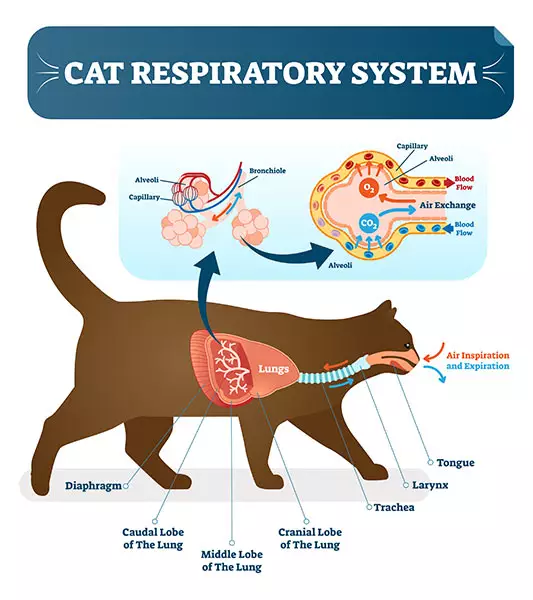
Symptoms of respiratory tract infection in cats
The typical upper respiratory infection in cats involves the nose and throat, causing symptoms such as sneezing, nasal congestion and discharge from the nose or eyes. More generalised symptoms such as a fever, poor appetite, and lethargy may also occur.
Although they will differ depending on the cause and location of the infection, some of the more common symptoms of upper respiratory infections in cats include:
- Sneezing
- Nasal congestion
- Nasal discharge / runny nose
- Coughing
- Hoarseness or loss of voice
- Fever
- Decreased appetite
- Sinus congestion
- Drooling
- Open mouth breathing
- Enlarged lymph nodes
- Lethargy
- Depression
- Nasal and oral ulcers
- Squinting or rubbing eyes
- Watery eyes / discharge from eyes
- Conjunctivitis (inflammation of the eyelids)
- Corneal ulcers
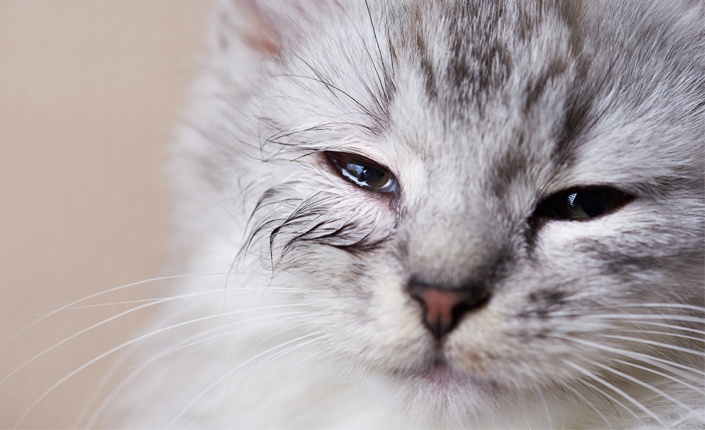
Respiratory tract infection in cats. Upper respiratory infection in cats; Cat respiratory infection
Source: https://www.petsplusus.com/sites/current.petsplusus.com/files/styles/news/public/news/705x430_Respitory.jpg
Causes of respiratory tract infection in cats
By far, viruses are the most common causes of upper respiratory infections in cats. The most common viruses that cause upper respiratory infections in cats and responsible for approximately 90% of all cases are Feline Herpesvirus and Feline Calicivirus:
Feline Herpesvirus Type-1 (also known as feline viral rhinotracheitis or FVR):
- A more severe form of virus that is highly contagious.
- Common symptoms are eye infections, coughing, sneezing, loss of appetite, pharyngitis (sore throat), corneal ulceration and inflamed trachea.
- All infected cats become chronic carriers, meaning that they will have the disease essentially for life; it is likely to reactivate during times of stress.
Feline Calicivirus (FCV):
- Less severe symptoms are experienced, although more mouth ulceration may occur.
- There is a greater risk of developing pneumonia with this virus.
- About half of infected cats will remain infected as carriers, in some cases for a few months after symptoms cease, and in rare cases, for life.
These two viruses occur frequently in cats because:
- They are highly contagious as they are present in the saliva and discharge produced by the eyes and nose and can be transmitted from cat to cat through sneezing, coughing or while grooming or sharing food and water bowls.
- They are prevalent in shelters, catteries and multi-cat households.
- Once infected, cats can become carriers, and though they may not show clinical signs, they can still transmit the viruses to others.
In rare cases bacterial infections may be responsible for upper respiratory infections in cats. Cats can develop bacterial infections secondary to viral infections. The most common bacterial cause of URTI’s are:
- Bordetella bronchiseptica (B. bronchiseptica) – generally associated with fever, sneezing, swollen lymph nodes and lung complications.
- Chlamydophila felis (C. felis) – often associated with eye infections and mild sneezing.
Other less common agents that may be contributing factors in an upper respiratory infection in cats include:
- Mycoplasma spp. – a bacterial infection with symptoms of ocular discharge and eye swelling.
- Feline reovirus – a viral infection of the intestines that can mimic symptoms of a respiratory infection.
- Pasteurella – a bacterial infection that is often transmitted via animal bites.
Other factors that may increase susceptibility to, or play a role in the development of, an upper respiratory infection in cats include:
- Age – kittens and elderly cats are more susceptible
- Breed – certain breeds like Persians and other flat-faced breeds appear to have a predisposition to develop upper respiratory infections
- Vaccination status – unvaccinated cats are more susceptible
- Overall health – cats with immune deficiencies are more susceptible
- Overcrowding, living in a multi-cat household, cattery, boarding facility or shelter
- Poor sanitation
- Contaminated crates, cages, bedding, bowls and clothing
- Stress
How is respiratory tract infection in cats diagnosed?
Diagnosing feline upper respiratory infection is generally based on a physical examination and the presence of characteristic symptoms such as fever, congestion, sneezing, watery eyes and nasal discharge.
Determining the exact viral or bacterial cause of the infection can be difficult and is not always necessary. These diagnostic tests are usually performed only on severely affected cats or where multiple cats have been exposed.
Some of the diagnostic tests that might prove helpful, particularly if the cat has chronic symptom is responding poorly to treatment of the infection, include:
- Nasal, eye or throat swabs to detect pathogens that could be causing the infection.
- Complete blood count (CBC) to determine how the body is responding to the infection.
- Blood chemistry profile to determine the animal’s overall health.
- Chest x-rays to evaluate the lungs, particularly if pneumonia is suspected.
- On examination, a check for oral ulcers, which can be caused by caused by FVR and FCV.
- Tests for FIV (Feline Immunodeficiency Virus) or FeLV (Feline Leukemia Virus), if these are suspected, as they can make the cat more susceptible to URTI’s.
Prognosis
Upper respiratory infection in cats are extremely common. Fortunately, however, severe illnesses that are secondary to URTI’s are much less common and the vast majority of cats make a rapid and full recovery. Therefore, the prognosis is very good in most cats.
Left untreated, feline upper respiratory infections can occasionally progress to pneumonia or have other serious complications, such as chronic breathing difficulties. Very young kittens have a higher incidence of pneumonia and some do not survive the infection. The prognosis is worst in cats that are very young and those with virulent strains of the calicivirus.
Treatment for respiratory tract infection in cats
Most cats with an uncomplicated upper respiratory infection can be treated at home. As there is no cure for viral infections, treatment is targeted at relieving the symptoms. The veterinarian will prescribe the best course of treatment, depending on the cat’s particular symptoms and the severity of the infection. Severely ill cats may require hospitalisation.
Treatment options include:
Medication
Antibiotics:
- Although viral infections do not respond to antibacterial drugs, if the cat has developed any secondary infections, antibiotics will be prescribed.
- Antibiotics may also be used in an effort to prevent secondary bacterial infections from complicating the disease, particularly in kittens and elderly cats.
- Primary bacterial upper respiratory infections caused by Bordetella or Chlamydophila will be treated with specific antibiotics that are effective against these diseases.
Ophthalmic ointment:
- Your veterinarian may prescribe a topical eye ointment if the cat has a purulent (pus-like) eye discharge or corneal ulcers.
Decongestants:
- Some cats may benefit from decongestant nose drops if the nasal congestion is particularly severe.
Topical antiviral agents:
- In severe cases, these medications are applied locally as an ointment or cream to treat the infection.
Nutritional support
- As cats with a respiratory infection have a decreased sense of smell, they often have a decreased appetite and are at risk of developing anorexia (refusal to eat).
- Provide appetising cat food, such as canned food which usually smells better to cats and encourages eating, and moist food which is less scratchy to an inflamed throat.
- Warming the food or adding warm water to it may entice the cat to eat.
- If the cat continues to refuse to eat, an appetite stimulant may be prescribed.
- If weight loss becomes too severe and the cat is not responding to food, a feeding tube or oral syringe may be required to ensure the cat takes in sufficient nutrients and fluids.
- Supplemental potassium or vitamin B complex may be prescribed.
- If the cat refuses to drink, there is a risk of dehydration, and fluids may need to be provided subcutaneously.
- If the cat is not eating and/or drinking, consult the veterinarian.
Additional care and support
- Cats with nasal or airway congestion may be exposed to a humidifier or taken into a steamy bathroom for 10 to 15 minutes several times per day.
- Wipe the cat’s nose or eyes gently with a moist tissue or washcloth to minimise irritation from nasal and eye discharges.
- Encourage the cat to rest as much as possible.
- Keep the cat indoors and away from other cats until fully recovered to minimise the potential for viral spread of the infection.
Prevention
- Vaccination may lessen severity of infection and can protect the cat from the most common causes of and upper respiratory infection: FVR and FVC.
- Disinfection and good hygiene are highly effective in minimising environmental exposure; regularly disinfect shared items such as litter boxes, food bowls and bedding.
- Practice good hygiene and wash your hands thoroughly when handling multiple cats.
- Keeping the cat indoors will minimise the risk of exposure to infected animals.
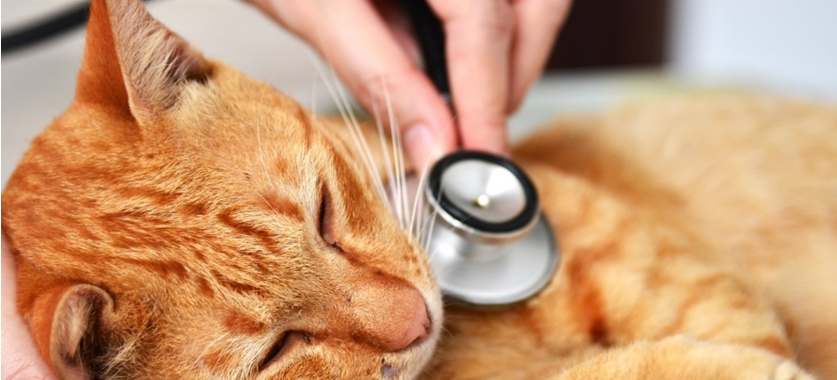
In a nutshell
Feline upper respiratory infection (URTI) is the common term for a respiratory infection of the nose, throat and/or sinuses. Sniffling, sneezing, discharge from the eyes and/or nose, coughing and lethargy are common symptoms; fever and sinus congestion may also occur.
Upper respiratory infections are extremely common and contagious among cats. They are mainly caused by viral infections, however, less frequently, bacterial infections may be responsible. The two primary viruses involved are feline herpesvirus-1 (FHV) and feline calicivirus (FCV). Cats may develop bacterial infections secondary to these common viral infections.
Diagnosis of an upper respiratory infection is based on the characteristic clinical signs. Specific identification of the underlying cause is not usually necessary, as the disease typically resolves in 10 to 14 days without complications. The vet will determine the best course of treatment depending on the symptoms the cat is exhibiting and the severity of the infection.
Bow Wow Meow Pet Insurance can help protect you and your cat should an unexpected trip to the vet occur.
-
Find out more about our cat insurance options
-
Get an online pet insurance quote
Bow Wow Meow is proud to have been awarded winner of Canstar’s ‘Most Satisfied Customers’ Award in the Pet Insurance category for both 2024 and 2025!
Bow Wow Meow is proud to have been chosen as Product Review’s Pet Insurance Award Winner every year from 2018 to 2025! This is based on 2,995 independent customer reviews (as at 21/01/2025), with an overall rating of 4.3*
Google Review rating = 4.5* (based on 968 reviews)
Trust Pilot rating = 4.6* (based on 531 reviews)
Bow Wow Meow is proud to have been chosen as Product Review’s Pet Insurance Award Winner every year from 2018 to 2025! This is based on 2,995 independent customer reviews (as at 21/01/2025), with an overall rating of 4.3*
Google Review rating = 4.5* (based on 968 reviews)
Trust Pilot rating = 4.6* (based on 531 reviews)
Bow Wow Meow has been chosen as a winner in the Finder Pet Insurance Awards 2024. Finder’s panel of experts analysed over 140 quotes to award our Ultimate Care Plan the winner of the “Pet Insurance – Value” category.
More information
https://vcahospitals.com/know-your-pet/feline-upper-respiratory-infection
https://pets.webmd.com/cats/guide/upper-respiratory-infection-cats#1
https://www.petmd.com/cat/conditions/respiratory/treating-upper-respiratory-infections-cats
https://www.petplace.com/article/cats/pet-health/feline-upper-respiratory-tract-infections-urti/
https://wagwalking.com/cat/condition/upper-respiratory-infection






